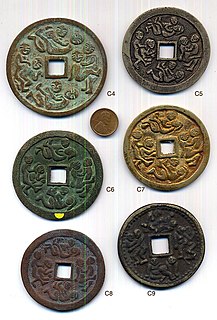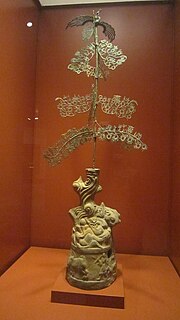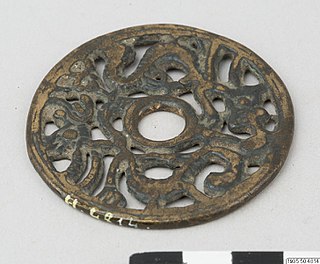 W
WYansheng Coins, commonly known as Chinese numismatic charms, refer to a collection of special decorative coins that are mainly used for rituals such as fortune telling, Chinese superstitions, and Feng shui. They originated during the Western Han dynasty as a variant of the contemporary Ban Liang and Wu Zhu cash coins. Over the centuries they evolved into their own commodity, with many different shapes and sizes. Their use was revitalized during the Republic of China era. Normally, these coins are privately funded and cast by a rich family for their own ceremonies, although a few types of coins have been cast by various governments or religious orders over the centuries. Chinese numismatic charms typically contain hidden symbolism and visual puns. Unlike cash coins which usually only contain two or four Hanzi characters on one side, Chinese numismatic charms often contain more characters and sometimes pictures on the same side.
 W
WBuddhist coin charms are a category of Chinese, Japanese, Korean, and Vietnamese numismatic charms that depict Buddhist religious imagery or inscriptions. These coin charms often imitate the design of Chinese cash coins, but can exist in many different shapes and sizes. In these countries similar numismatic charms existed for Confucianism and Taoism, and at times Buddhist coin charms would also incorporate symbolism from these other religions.
 W
WChinese burial money a.k.a. dark coins are Chinese imitations of currency that are placed in the grave of a person that is to be buried. The practice dates to the Shang dynasty when cowrie shells were used, in the belief that the money would be used in the afterlife as a bribe to Yan Wang for a more favourable spiritual destination. The practice changed to replica currency to deter grave robbers, and these coins and other imitation currencies were referred to as clay money (泥錢) or earthenware money (陶土幣).
 W
WCoin-swords, or cash-swords, are a type of Chinese numismatic charms that are a form of feng shui talisman that were primarily used in southern China to ward off evil spirits and malicious influences, especially those inducing fever. These coin-swords are also often used in Taoist rituals. Coin-swords are considered an "evil-warding sword" in China.
 W
WHell money is a form of joss paper printed to resemble legal tender bank notes. The notes are not an official form of recognized currency or legal tender since their sole intended purpose is to be offered as burnt offerings to the deceased as a solution to resolve their assumed monetary problems in the afterlife. This ritual has been practiced by the modern Chinese and across East Asia since the late 19th century. Early 20th century examples bore resemblance to minor commercial currency of the type issued by businesses across China until the mid-1940s.
 W
WHorse coins, alternatively dama qian (打馬錢), are a type of Chinese numismatic charm that originated in the Song dynasty and presumed to have been used as gambling tokens. Although many literary figures wrote about these coins their usage has always been failed to be mentioned by them. Most horse coins tend to be round coins, 3 centimeters in diameter with a circular or square hole in the middle of the coin. The horses featured on horse coins are depicted in various positions such as lying asleep on the ground, turning their head while neighing, or galloping forward with their tails rising high. it is currently unknown how horse coins were actually used though it is speculated that Chinese horse coins were actually used as game board pieces or gambling counters. Horse coins are most often manufactured from copper or bronze, but in a few documented cases they may also be made from animal horns or ivory. The horse coins produced during the Song dynasty are considered to be those of the best quality and craftsmanship and tend be made from better metal than the horse coins produced after. Some horse coins would feature the name of the famous horses they depicted. It is estimated that there are over three hundred variants of the horse coin. Some horse coins contained only an image of a horse while others also included an image of the rider and others had inscriptions which identify the horse or rider. During the beginning of the year of the horse in 2002 Chinese researchers Jian Ning and Wang Liyan of the National Museum of Chinese History wrote articles on horse coins in the China Cultural Relics Newspaper, noting that they found it a pity that the holes in the coins covered the saddles of the horses as this could have revealed more about ancient horse culture. Horse coins from the Song dynasty are the horse coins that are produced at the highest quality while horse coins from subsequent dynasties tend to be inferior compared to them.
 W
WJoss paper, also known as incense papers, are papercrafts or sheets of paper made into burnt offerings common in Chinese ancestral worship. Worship of Deities in Chinese folk religion also uses a similar type of joss paper. Joss paper, as well as other papier-mâché items, are also burned or buried in various Asian funerals, "to ensure that the spirit of the deceased has sufficient needs in the afterlife." In Taiwan alone, the annual revenue of temples received from burning joss paper was US$400 million as of 2014.
 W
WLei Ting curse charms, or Lôi Đình curse charms, are a type of Chinese and Vietnamese numismatic charms, these charms can be described as a talismanic coin as they are often based on Chinese cash coins but can also have round holes instead of square ones and may also be shaped like gourd charms.
 W
WLock charms are Chinese numismatic charms shaped like ancient Chinese security locks. Their shape resembles a basket or in most cases the Chinese character for "concave" (凹). The pendants tend to be flat, without any moving parts, or the functionality of the locks they symbolize. They are decorated with both Chinese characters and symbols. Like other types of Chinese numismatic charms, lock charms are meant to protect the wearers from harm, misfortune, and evil spirits, and to bless them with good luck, longevity, and a high rank. In particular, this talisman is meant for young boys, to help "lock" them to the earth, to guard them from death.
 W
WMarriage coin charms are a category of Chinese, Japanese, Korean, and Vietnamese numismatic charms that depict marriage, harmonious, and/or sexual imagery. These coin charms often imitate the design of Chinese cash coins, but can exist in many different shapes and sizes.
 W
WChinese legend has it that the money tree (搖錢樹) is a type of holy tree that can bring money and fortune to the people, and that it is a symbol of affluence, nobility and auspiciousness. It can be traced back to primitive societies when the adoration of a holy tree was prevalent. Whilst Money trees may be derived from the Sun tree myth associated with paradise, the coins link paradise with a material bounty in this world. According to the existing historical narratives, the concept of the "money tree" is derived at the latest from the Han Dynasty. Cast-bronze money trees are a conspicuous feature of Han tombs in Sichuan.
 W
WOpen-work charms are a type of Chinese, Japanese, Korean, and Vietnamese numismatic charms characterised by irregularly shaped "holes" or "openings" between their design elements known as openwork. The design of the amulets represent yin while the holes represent yang and their general purpose was to attract good fortune and ward off evil spirits and misfortune. Unlike most other types of Chinese numismatic charms which usually tend to have square center holes if they’re holed, open-work charms tend to almost exclusively have round center holes though open-work charms with square center holes are known to exist and certain thematic open-work charms that feature human-made constructions mostly told to have square holes. Another distinctive feature of open-work charms is that they’re almost purely based on illustrative imagery and only a small minority of them contain legends written in Hanzi characters. While most other forms of Chinese numismatic charms are made from brass open-work charms are predominantly made from bronze.
 W
WTaoist coin charms, or Daoist coin charms are a family of categories of Chinese and Vietnamese numismatic charms that incorporate elements of the Taoist religion. Taoist coin charms come in various shapes, sizes, and formats and can contain inscriptions or wholly pictorial designs. While a large number of Taoist coin charms have their inscriptions written in traditional Chinese characters, a subset of Taoist coin charms have inscriptions written in Taoist "magic" writing. In these countries similar numismatic charms existed for Buddhist and Confucianism, and at times Taoist coin charms would also incorporate symbolism from these other religions.
 W
WVault Protector coins were a type of Chinese numismatic charm coins created by Chinese mints. These coins were significantly larger, heavier and thicker than regular cash coins and were well-made as they were designed to occupy a special place within the treasury of the mint. The treasury had a spirit hall for offerings to the gods of the Chinese pantheon, and Vault Protector coins would be hung with red silk and tassels for the Chinese God of Wealth. These coins were believed to have charm-like magical powers that would protect the vault while bringing wealth and fortune to the treasury.
 W
WThe Zhengde Tongbao is a fantasy cash coin, Chinese, and Vietnamese numismatic charm bearing an inscription based on the reign title of the Zhengde Emperor of the Ming dynasty. The Zhengde Emperor reigned from the year 1505 until 1521, however during this period no circulating cash coins were minted. There were a large amount "cash coins" bearing the Zhengde era name are minted from the late Ming to early Qing dynasty periods as superstitious "lucky coins" with auspicious depictions and instructions, as this inscription remained popular for charms modern reproductions of the Zhengde Tongbao are also very common.